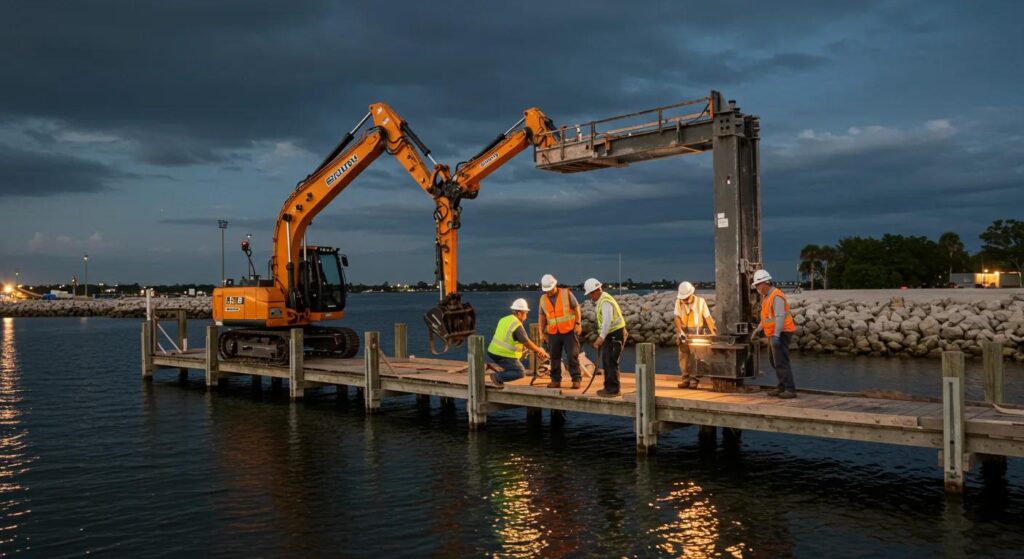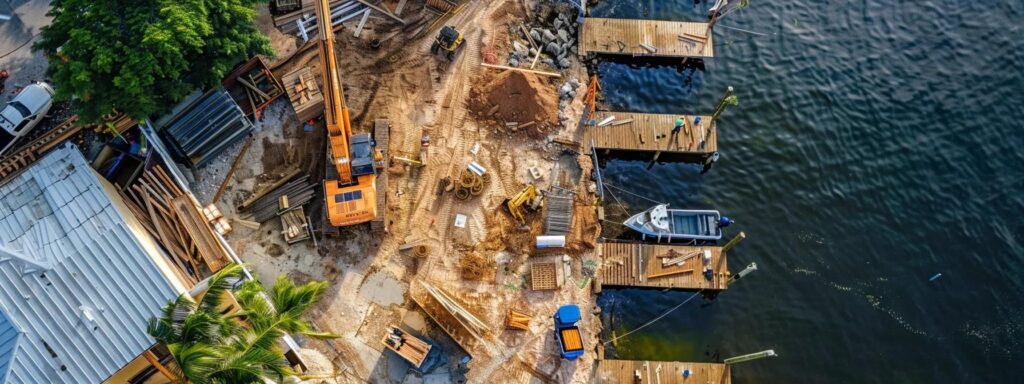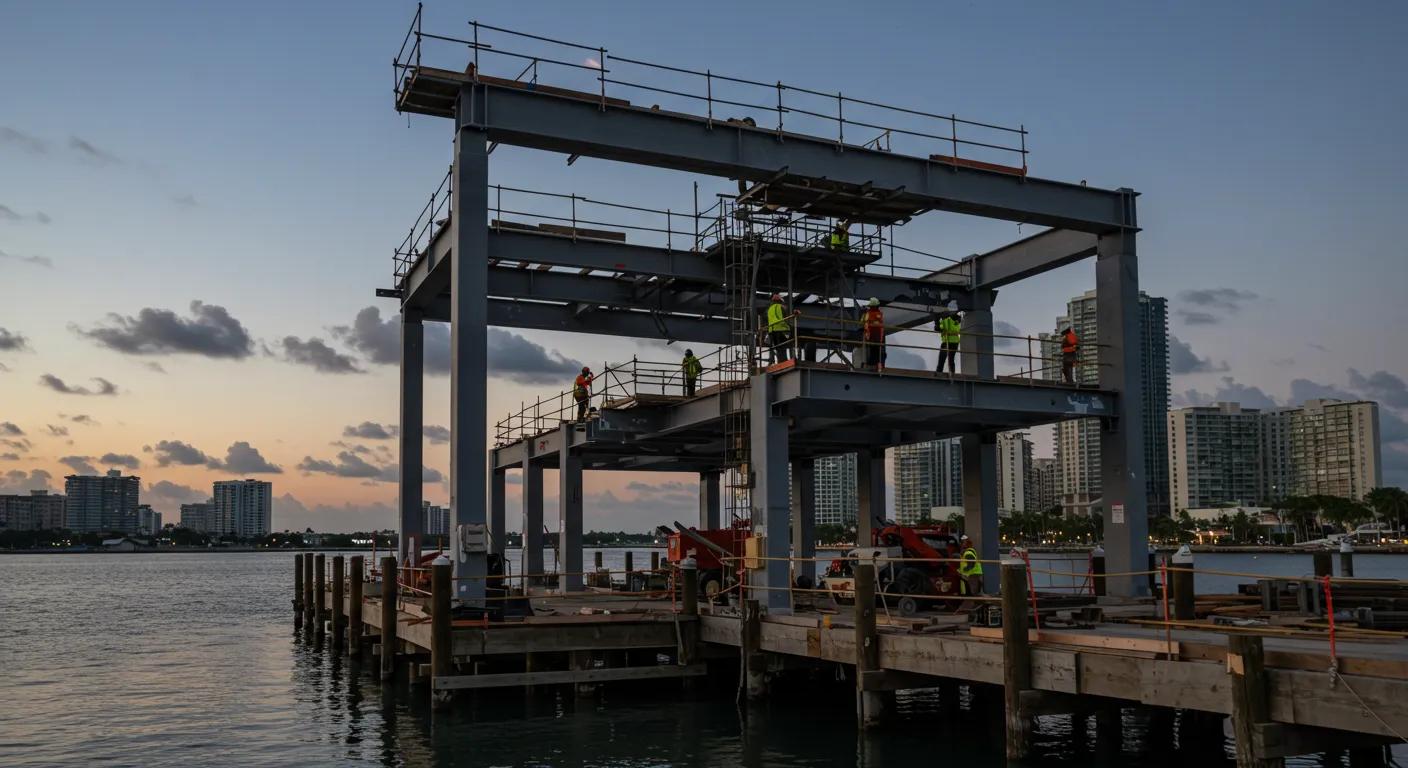Why Considering Long-Term Dock Maintenance Can Save You Money on Initial Construction
Maintaining a dock is an investment often overlooked until unexpected repairs force costly fixes. When constructing a dock, the focus is usually on an attractive and functional structure. However, neglecting long-term maintenance can lead to escalating costs from repairs, debris accumulation, material wear, and overall deterioration. This article explains how ongoing maintenance preserves your dock’s appearance, protects your investment, ensures regulatory compliance, and safeguards both the environment and your bottom line.
The article provides a guide on how regular dock upkeep improves cost management by preventing unnecessary expenses, reducing repair frequency, and extending the dock’s life. It also explores how technology can streamline maintenance practices so you can avoid overruns and enhance operational safety and durability.
Understand the Role of Dock Maintenance in Cost Management
Regular maintenance helps control and reduce construction and repair expenses by preventing piecemeal fixes that add up over time. Thorough cleaning of debris from the dock surface and seabed minimizes accelerated decay and related repair costs for materials such as concrete, wood, and steel.
Identify Key Areas Where Dock Maintenance Prevents Expenses
Daily, weekly, and seasonal tasks help prevent progressive wear and tear. Regular cleaning removes salt and corrosive elements from hardwood, lumber, and steel, preventing minor damage from evolving into full board or deck replacements. Keeping the dock free of marine growth also reduces slip hazards and liability costs.
Analyze the Long-Term Benefits of Dock Upkeep on Budgets
Investing in regular dock maintenance establishes a predictable spending pattern. Inspections and routine repairs can reduce overall repair costs—sometimes by as much as 40%—while preserving or even increasing your property’s value. The savings can free up budgets for other improvements along your waterfront.
Consider How Regular Maintenance Minimizes Equipment Wear
Every component—from mooring mechanisms to concrete footings—suffers daily wear. Routine lubrication, timely inspections for rust, and preventive treatments on wood extend equipment lifespan. Early intervention reduces the need for expensive replacements and improves overall operational efficiency.
Evaluate the Impact on Safety and Liability Costs Over Time
Neglecting maintenance can compromise safety, increasing the risk of structural failures and liability claims. Regular inspections and timely repairs reduce the likelihood of dangerous failures that lead to injuries. High safety standards also lower insurance premiums and mitigate legal and compliance costs.
Communicate the Importance of Dock Condition Assessments
Regular assessments of your dock’s condition help detect issues such as plastic degradation, corrosion, or hidden wear early. Documented condition reports support discussions with insurers and regulators, justifying repairs and resulting in more accurate contractor estimates.
Review Case Studies Highlighting Cost-Saving Maintenance Strategies
Case studies consistently show that docks maintained on regular schedules experience fewer dramatic failures and emergency repairs. Both residential and commercial marina examples demonstrate that proper maintenance pays for itself over time through lower repair costs and improved longevity.
Implement Effective Dock Maintenance Schedules for Savings

An effective maintenance schedule is vital for optimizing your construction budget. A planned routine for inspections and repairs prevents surprises and costly emergency fixes, while reducing downtime and enhancing safety.
Outline Essential Maintenance Tasks to Include in Schedules
A comprehensive schedule should include tasks like: • Cleaning: Remove accumulated debris, marine growth, and salt residues from all dock surfaces. • Inspections: Check critical areas such as bearing structures, mooring points, and underwater components. • Repairs: Address any signs of corrosion on steel supports or decay in wood elements. • Documentation: Record navigation channel checks, docking mechanism status, and lighting reviews.
This roadmap not only extends dock longevity but also minimizes costly future repairs.
Suggest Frequency for Inspections and Repairs to Ensure Efficiency
Maintenance frequency depends on environmental exposure and usage intensity. A monthly visual inspection helps catch early signs of damage, with deeper seasonal reviews every three to six months. Minor issues should be addressed within 30 days of detection, while major repairs require detailed planning and budgeting. Regular assessments keep the dock in prime condition and can forecast when major overhauls are more cost-effective than emergency fixes.
Prioritize Dock Maintenance Tasks Based on Criticality
Tasks should be prioritized based on their impact on safety, functionality, and long-term savings. Safety-critical areas (load-bearing structures, hazardous surfaces) require immediate attention, while cosmetic repairs may be scheduled less often. Prioritizing ensures optimal resource allocation and protects against injuries or major failures.
Combine Regular Checks With Seasonal Dock Upkeep
Environmental conditions demand different approaches. Winter brings salt exposure and moisture that accelerate corrosion and frost damage, while summer increases UV exposure and boat activity. By combining weekly or monthly checks with seasonal thorough maintenance, the dock is well-prepared for each climate period, forestalling costly deterioration.
Document Maintenance Activities to Track Spending Impact
Keeping detailed records—including cleaning logs, repair invoices, and inspection reports—helps track spending, measure maintenance effectiveness, and demonstrate compliance with safety standards. This documentation can optimize future budgeting and potentially improve resale value.
Collaborate With Maintenance Teams to Optimize Workflows
Effective dock maintenance requires open communication among property owners, contractors, and maintenance teams. Regular meetings, project management software, and shared inspection reports improve coordination and ensure that maintenance tasks are executed efficiently, keeping the dock safe and reducing long-term costs.
Explore Technology's Role in Dock Maintenance Efficiency
Technology has transformed dock maintenance by making inspections and repairs more predictable and data-driven. Modern solutions reduce downtime and yield more consistent outcomes.
Investigate Software Solutions for Maintenance Management
Maintenance management software can streamline scheduling, reporting, and task tracking via digital dashboards. Such platforms help reduce oversight risks, track repair histories, predict future needs, and incorporate budgeting tools—ensuring overall cost management is efficient.
Assess the Use of Predictive Maintenance Technologies
Predictive maintenance uses data analytics to forecast when repairs are needed, helping turn minor issues into manageable fixes before they become major failures. This approach reduces emergency repair calls and stabilizes budgets by ensuring repairs occur at just the right time.
Use Drones for Dock Inspections to Reduce Downtime
Drones equipped with high-resolution cameras can inspect hard-to-reach areas quickly and safely. They detect early signs of damage on the underside of docks or areas with heavy marine growth, reducing the need for labor-intensive manual inspections and saving both time and money.
Implement Sensor Technologies for Real-Time Monitoring
Sensors that monitor voltage, moisture, and vibrations provide real-time data on dock conditions. These alerts allow for immediate corrective actions, preventing further deterioration and expensive downtime, enhancing both safety and efficiency.
Analyze Cost Savings From Automated Maintenance Scheduling
Automated scheduling powered by artificial intelligence can optimize maintenance timelines by analyzing historical data. This system minimizes downtime and spreads labor costs more evenly, contributing to smoother operations and lower expenses overall.
Compare Traditional vs. Tech-Assisted Maintenance Methodologies
Traditional manual inspections and fixed schedules lack the flexibility to adapt to environmental changes. In contrast, tech-assisted methodologies adjust maintenance based on real-time data and predictive analytics, resulting in improved safety and cost efficiency. Embracing technological tools sets new standards for operational excellence and budget management.
Reduce Construction Delays Through Proactive Dock Upkeep

Proactive dock maintenance not only saves money but also minimizes construction delays. A well-maintained dock keeps project schedules on track and ensures that waterfront operations continue without interruption.
Highlight the Link Between Dock Condition and Project Timelines
A dock in peak condition enables smoother project execution. When components like the seabed, mooring points, and deck surfaces are intact, construction teams can work without delays. Regular maintenance can reduce delays by up to 30%, ensuring a timely progress during peak periods.
Identify Potential Delays Caused by Neglected Dock Maintenance
Neglect leads to deteriorating conditions that can halt construction. Damaged materials or debris accumulation may trigger safety audits and force work suspensions. Early identification of such issues prevents costly project resets and ensures that every part of the construction process stays on schedule.
Discuss Strategies to Create Contingency Plans for Dock Issues
Effective contingency planning involves setting aside funds for maintenance, keeping a small inventory of repair materials, and forming rapid response teams. These measures allow for quick fixes before minor issues evolve into major delays and keep construction timelines intact.
Outline Communication Protocols During Dock Maintenance
Clear communication between maintenance crews, project managers, and safety inspectors is vital. Daily briefings, scheduled software updates, and immediate alerts ensure everyone is aware of progress, potential delays, or necessary adjustments. Such protocols support a smooth transition from maintenance work back to construction activities.
Suggest Ways to Align Dock Maintenance With Project Schedules
Integrate maintenance tasks into project timelines to avoid conflicts. Schedule inspections and repairs during off-peak or planned downtime, and consider flexible shifts to prevent disruption of heavy construction activities. This alignment minimizes delays and supports uninterrupted progress through strategic planning.
Review Case Studies of Successful Dock Maintenance Strategies
Recent projects have demonstrated that proactive maintenance can reduce downtime by more than 20%. Waterfront construction projects that incorporated real-time sensor data and predictive scheduling experienced minimal disruptions, underscoring the benefits of clear planning and management.
Measure the Financial Impact of Dock Maintenance Practices
Measuring the financial impact of maintenance helps justify investments in proactive upkeep. Comparing routine expenses with emergency repair costs highlights the long-term benefits of proper maintenance practices.
Establish Key Metrics to Assess Maintenance Effectiveness
Key metrics include repair frequency, average repair costs, downtime, and safety incident rates. Tracking these indicators can show improvements and demonstrate that regular maintenance reduces annual repair costs by a significant margin.
Calculate Cost Savings From Preventative Dock Upkeep
A cost analysis comparing reactive repairs with preventive maintenance reveals substantial savings. Minor touch-ups are far less expensive than full-scale replacements. Over time, a proactive strategy may save up to 30% on annual expenses, making a strong financial case for routine maintenance.
Compare Repair Costs Versus Routine Maintenance Expenses
| Cost Aspect | Repair Costs (Reactive) | Routine Maintenance Costs |
|---|---|---|
| Average annual spending | High (unpredictable) | Low to moderate (predictable) |
| Emergency intervention frequency | Frequent | Rare |
| Impact on project downtime | Significant | Minimal |
| Long-term ROI | Low | High |
Understanding this balance is crucial to ensuring that long-term savings and improved ROI justify the initial maintenance investment.
Analyze the Return on Investment for Dock Maintenance Efforts
Regular maintenance not only preserves the dock’s condition but also adds value to the property. Improved ROI—through increased lifespan and reduced repair expenditures—supports proposals for higher maintenance budgets and better contractor negotiations.
Assess Indirect Savings From Improved Safety and Productivity
Beyond direct savings, regular maintenance enhances safety and productivity. Fewer accidents and minimized downtime allow workers to operate efficiently, reducing liability costs and insurance premiums. These indirect benefits further accelerate project completion and overall cost efficiency.
Use Data to Advocate for Increased Maintenance Budgets
Accurate performance metrics support requests for higher budgets, ensuring that ongoing maintenance remains a priority. Solid data on lower repair costs, extended asset longevity, and improved safety outcomes make a persuasive financial argument.
Foster a Culture of Maintenance Within the Construction Team

A proactive maintenance culture within your team boosts both efficiency and longevity of the dock. When every team member values regular upkeep, the benefits extend to improved safety, reduced costs, and a more collaborative work environment.
Promote Training Programs Focused on Dock Upkeep Awareness
Invest in training that covers the latest maintenance technologies, issue identification, and repair techniques. Regular workshops and hands-on sessions ensure all team members understand proper procedures and safety requirements.
Encourage Team Involvement in Maintenance Planning
Engage the maintenance team in planning to foster ownership and responsibility. Feedback from technicians and field workers helps identify practical improvements and ensures that maintenance protocols remain effective and relevant.
Share Success Stories to Highlight Maintenance Benefits
Regular review meetings and case study discussions inspire teams by showcasing examples where proactive maintenance led to significant savings and smoother project execution.
Lead Regular Workshops to Reinforce Maintenance Importance
Monthly or quarterly workshops on new technologies, repair methods, and regulatory updates keep maintenance top of mind. These sessions drive continuous improvement and maintain high performance standards.
Establish a Reward System for Proactive Maintenance Efforts
Recognize and reward employees who contribute to proactive maintenance. Incentives such as bonuses or public acknowledgment reinforce positive behavior and motivate the team to maintain high standards.
Collaborate on Maintenance Workshops With Industry Experts
Partner with external experts for workshops that introduce advanced training methods and emerging trends. This collaboration strengthens professional networks and enhances overall operational standards.
Frequently Asked Questions
Q: How does regular dock maintenance save money over time? A: It prevents costly emergency repairs by addressing issues like debris accumulation, corrosion, and material degradation early, extending the dock’s lifespan and minimizing downtime.
Q: What are some essential dock maintenance tasks I should include in my schedule? A: Tasks include regular cleaning to remove debris and salt, routine inspections of structural components, lubrication of moving parts, and prompt repairs for signs of corrosion or wear. Documentation of these activities is also important.
Q: Can technology really improve dock maintenance efficiency? A: Yes. Tools such as maintenance management software, drone inspections, and real-time sensor monitoring streamline tasks, reduce manual labor, and provide predictive analytics for better scheduling and cost savings.
Q: How can I ensure that my dock maintenance schedule aligns with construction timelines? A: By integrating routine inspections and repairs into overall project milestones and scheduling them during off-peak hours, you can minimize delays. Effective communication and contingency plans are also essential.
Q: What metrics should I use to measure the effectiveness of my dock maintenance practices? A: Key metrics include repair frequency, downtime, overall repair costs, safety incident rates, and the ROI of preventive maintenance versus emergency fixes.
Q: What steps can I take to foster a culture of maintenance within my team? A: Promote regular training, involve team members in maintenance planning, share success stories, establish reward systems, and collaborate with industry experts to build collective commitment and high safety standards.
Final Thoughts
Regular dock maintenance is not just about preserving structural integrity; it is a strategic investment in your financial and operational future. A comprehensive maintenance schedule, combined with modern technology and a proactive maintenance culture, ensures your dock remains in peak condition. In turn, this reduces operational risks, improves safety standards, and leads to significant long-term savings. Embrace proactive maintenance to secure lasting value and operational excellence in your dock construction and upkeep.




